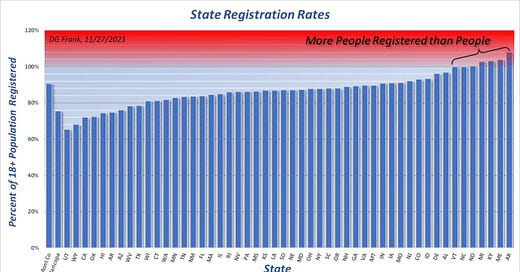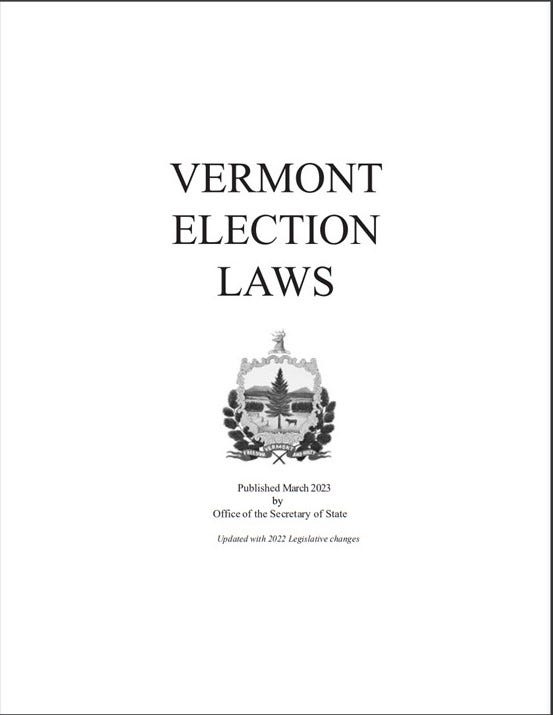In the first two parts of this series, Part One explored Voter Rolls: The Election Fraud Credit Line and Part Two explored Using Centralized Management to Drive the Results. We’ll now turn to Vermont’s situation, looking at the voter rolls and election operations.
Voter Rolls
With respect to voter rolls, while Vermont is not as bad as Wisconsin, where there are nearly two voters on the rolls for every legal age adult in the state, Vermont has many towns with registrations equaling 100% of the voter age population on the rolls, and is one of seven states in the country with 100% registration rate.
Vermont is a member of the Electronic Registration Information Center (ERIC). Its membership consists of state-level election officials from member states. Will Senning, the Director of Elections under the Secretary of State, is the Vermont representative. As Ken Blackwell, Chair of the Center for Election Integrity at the America First Policy Institute (AFPI) stated, “ERIC was initially sold as a non-partisan data system to clean voter rolls. However, it has been transformed into a system that lacks transparency, compromises voter information, and focuses on states registering voters rather than cleaning voter rolls.”
Board of Civil Authority
Each municipality in Vermont has a board of civil authority. In most towns, this board is headed by the town clerk. Membership also consists of the town select board, elected Justices of the Peace (JP) and optionally appointed JPs. Each municipality by law should have three Justices of the Peace from each major party. If sufficient JPs are not elected from each party, there is a process for the party to nominate and have appointed additional JPs up to the three per party. These appointed JPs solely participate on the BCA for elections and do not fulfill other roles of the Justice of the Peace. This is more fully detailed in the Vermont State Justice of the Peace Guidebook.
The BCA is responsible for keeping the voter rolls clean. Given the Vermont statues and different entities providing input to the voter rolls, this can be a daunting task. Vermont Statute requires challenged voters to be retained on the voter rolls for two general election cycles after the challenge, unless the voter responds to the challenge letter or if a vote is cast in that voter’s name. A voter challenged without response in 2023 will not be removed until after the 2026 general election. Vermont DMV transactions automatically register voters unless the voter opts out of the registration. Voters also have the ability to register and maintain their registration through the My Voter Page at the Vermont Secretary of State Office and to register with the town clerk.
Ballot Process
While Article 8 of the Vermont constitution is simple and clear, the same cannot be said about Vermont election law. The Secretary of State publishes a Vermont Election Laws Handbook that is a great cure for insomnia. In 2021, Vermont passed Senate Bill 21, which mandated universal mail-in ballots without signature verification. In 2005, former President Jimmy Carter and former U.S. Secretary of State James A. Baker III co-chaired the Commission on Federal Election Reform in 2005, which produced a report on the U.S. electoral process and recommendations on maximizing ballot access and election integrity. The report warned, “Absentee ballots remain the largest source of potential voter fraud.” One can see where there is a significantly greater risk with universal mailing of ballots to all registered voters in a jurisdiction versus individual requesting an absentee ballot. When that is compounded by loose or no signature verification as America saw in the 2022 Arizona Gubernatorial contest, there becomes no chain of custody for the election, and election officials have no way of knowing who really cast ballots in any voter’s names. There have been numerous cases in Arizona, Vermont, and across the nation where voters arrived on election day to cast an in-person ballot to be told a ballot had already been cast in their name. Vermont’s Universal Ballots require a signature, but do not require any verification of that signature.
Seth Keshel has been a very active statistician in US elections since 2016. In 2016, he accurately predicted the outcome of the election based on national voter registration trends. In 2020, his predictions failed. He has done deep statistical analysis and projects that there was a significant number of excess votes that pushed Biden over the finish line. He promotes The Ten Points to True Election Integrity and Four for the Election Integrity Core – a subset of the ten points that in some cases can be actioned at the local level without legislative changes. His initial analysis of Vermont suggested that growth of 34,000 votes in 2020 were a statistical anomaly, not backed by changes in voter registration between 2016 and 2020. He has also posted a more recent analysis on Rumble with the Vermont Analysis Summary, where he believes Biden received over 53,000 excess votes in the Vermont 2020 Presidential Election. When Dr. Frank visited Vermont in January of this year, he discussed how the voter rolls have grown over the years without an immediate use of the excess registrations, banked for future need. It appears significant withdrawals of that banked credit was done in 2020.
Without Corruption?
In Part Two I discussed how New York Citizen’s Audit validated that the 2022 General Election was not legally certified, as it did not meet federal election standards of less than 1 in 125,000. For the 2022 Vermont general election, this is less than three voters. From my own personal canvassing, I have found more than three votes that were cast in the name of voters that no longer lived at their registered address. Whether these were fraudulent votes, or illegal votes does not matter, what does matter is that these were not legal votes, and federal law only allows 1 in 125,000 ballots cast in a federal election to be in error. While the media may be saying three votes was not sufficient to change the results of the election, the fact is, three voters who cast legal votes were disenfranchised, and hence it does not appear the 2022 Vermont general election was valid according to federal law nor Vermont Constitution Article 8. I also observed a recount for a Bennington race for State Representative. Again, this recount resulted in more than a three-vote difference from the election night results. I’ve also talked to JPs who have done hand counts in their municipalities following the machine counts, and find that the votes are very close – perhaps one or two votes off. While generally this does not change the outcome of the election, it does not meet federal election law standards, or the Vermont constitution, and therefore, should not be certified.
Vermont has significant challenges in meeting the constitutional requirements of Article 8, “That all elections ought to be free and without corruption…” Our voter rolls are dirty, difficult to clean, and we allow same-day registration without identification. Our voter rolls are online, centrally managed, and shared with ERIC and numerous other third parties. Our general elections use universal mail ballots without signature verification, so we start with voter registrations that are dependent solely on the voter’s word, no other verification to the legality of the registration, and transition to ballots with no chain of custody through the rest of the voting process. We use Dominion machines in many municipalities, managed by an out-of-state contractor, LHS Associates. In all likelihood, the machines are connected to FirstNet. Election results go to Scytl, a foreign corporation for distribution to Edison and our Secretary of State Election Night Reporting.
Earlier this year, the Vermont GOP authorized an Election Integrity Committee. This brings hope to me that at least one political party in the state appears to be getting serious about ensuring we have elections that meet Article 8 of the Vermont Constitution. There are also grassroots efforts in the state working with Cause of America on Election Integrity. Vermont joins the other states in this nation raising up an army of citizens concerned about free and fair elections.
In part four of this series, I will explore Solutions to Restore Safe Elections.





